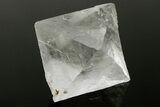This Specimen has been sold.
1.6" Translucent Fluorite Octahedron - Illinois
This is a beautiful fluorite octahedron that was found in Hardin County, Illinois. When viewed under UV lighting, a brilliant lavender fluorescence appears. There looks to be a few natural fractures throughout the specimen that add visual interest.
Miners used to cleave these octahedrons out of the high-grade fluorite in the mines. They were common in the 50's and 60's when the mines were operating in full swing, but are very hard to acquire now.
Miners used to cleave these octahedrons out of the high-grade fluorite in the mines. They were common in the 50's and 60's when the mines were operating in full swing, but are very hard to acquire now.
About Fluorite
Fluorite is a halide mineral comprised of calcium and fluorine, CaF2. The word fluorite is from the Latin fluo-, which means "to flow". In 1852 fluorite gave its name to the phenomenon known as fluorescence, or the property of fluorite to glow a different color depending upon the bandwidth of the ultraviolet light it is exposed to. Fluorite occurs commonly in cubic, octahedral, and dodecahedral crystals in many different colors. These colors range from colorless and completely transparent to yellow, green, blue, purple, pink, or black. Purples and greens tend to be the most common colors seen, and colorless, pink, and black are the rarest.
Fluorite is a halide mineral comprised of calcium and fluorine, CaF2. The word fluorite is from the Latin fluo-, which means "to flow". In 1852 fluorite gave its name to the phenomenon known as fluorescence, or the property of fluorite to glow a different color depending upon the bandwidth of the ultraviolet light it is exposed to. Fluorite occurs commonly in cubic, octahedral, and dodecahedral crystals in many different colors. These colors range from colorless and completely transparent to yellow, green, blue, purple, pink, or black. Purples and greens tend to be the most common colors seen, and colorless, pink, and black are the rarest.
 Reviews
Reviews













